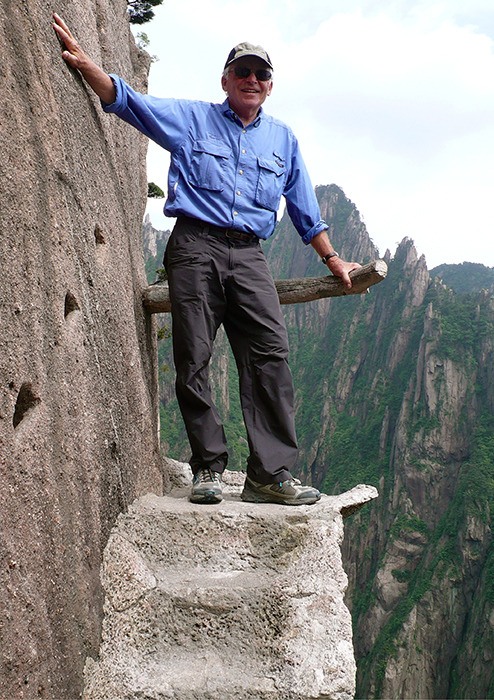A Wilmer resident who admits he speaks just enough Chinese to order a drink or two, but nonetheless has an affinity for Peking duck, was awarded honourary Chinese citizenship last month.
Jim Thorsell received the honour this past June from local government officials at Huangshan, a dramatic, mountainous area in the Anhui province in eastern China that is a United Nations Educational, Scientific and Cultural Organization (UNESCO) World Heritage Site. The citizenship was given in recognition of Mr. Thorsell’s decades of work advising on and helping parks management at Huangshan and other UNESCO sites and nature reserves around China.
“It was a really nice thing for them to do,” Mr. Thorsell told The Valley Echo, adding the event drew about 300 people and he ended up appearing in all kinds of Chinese media.
Originally from Banff, Mr. Thorsell began his career in parks and conservation more than 50 years ago when he started working for Parks Canada in Banff in 1962. After almost two decades, he relocated to Geneva, Switzerland to become head of the International Parks Commission (the scientific advisory organization for UNESCO’s World Heritage Committee) from the late 1970s until semi-retiring back to Canada in 2003.
During his International Park Commission role, he visited 108 countries to check out more than 800 parks, sites and nature reserves, from Antarctica, to Siberia to remote corners of the Congo.
Mr. Thorsell first visited China in 1985, a bit less than a decade after the Cultural Revolution ended, and says the country was vastly different in those days than it is now, with bicycles outnumbering cars by an incredible margin and people still wearing Mao suits.
Huangshan was China’s second-ever UNESCO site, having first applied for UNESCO status in 1988 and earning it in 1990. Mr. Thorsell was in charge of reviewing the application and making recommendations on how to improve management of the park.
“It is a great area, but management was initially weak,” he said. He ended up making multiple trips to the area, continually advising on how to run the place and saw dramatic changes.
“They’ve got one of the best-managed parks in the world now,” he said. “It does get pretty crowded sometimes, but they’ve got techniques to help spread the load.”
Visitor levels in Huangshan have surged from 250,000 people a year in the 1980s to 2.5 million people a year these days. Banff National Park, in comparison, gets four million visitors a year, although Huangshan is many times smaller in area than Banff.
Management techniques to reduce the stress of such a large number of visitors on the natural environment include everything from promoting the benefits of travelling to the park outside the normal tourist high seasons (and in so doing reducing the impact of the high-season crunch) to banning private vehicles in the park, capping accommodation and development in towns outside the park, and developing an elaborate trail system taking visitors through main areas and also onto remote cliffsides (with the idea that by keeping people on the trails instead of tromping around at random, nature will be less impacted).
“They’ve developed a truly fabulous trail system. I’ve walked for eight or nine days in that relatively small park, always on a different trail. They’re all well-built and superbly signed,” said Mr. Thorsell. “We lack that quality of trails here in Canada; we simply don’t have the means to do it.”
Perhaps the most surprising technique for managing the large number of visitors involves a team of 20 parks staff monitoring much of the park using remote surveillance cameras. If visitors start building up in certain areas in large enough numbers to create problems, the staff will contact guides in the park by cellphones to try and steer them and their tour groups away from these packed areas.
Although Huangshan sits in the middle of China’s heavily industrialized and agriculturalized east, much of the more remote fringe of the country contains some spectacular natural areas, according to Mr. Thorsell, adding the Three Parallel Rivers area in Yunnan province is probably his favourite park or nature reserve in Asia.
Having visited China multiple times during the past three decades, Mr. Thorsell has been witness to the country’s spectacular economic growth and rapid modernization during that time, and says the corresponding explosion of China’s middle class — and the attendant increase in nature tourism — is largely behind its swiftly developing conservation program.
“A lot of people would look at the negatives in China’s breakneck growth, the pollution and other environmental problems, not to mention a whole bunch of issues not related to the environment, but I try to look on the positive side as much as I can, and the nature conservation program they are developing there is really advanced,” he said. “I’ve got to give them credit. They’re doing a lot more research and putting a lot more effort into conservation that most other countries in the world.”
China has created nearly 1,000 parks and nature reserves in recent decades, said Mr. Thorsell, adding that there has also been a dramatic increase in the number of environmental science programs in Chinese universities.
Aside from continuing to consult with local governments around the world on conservation, Mr. Thorsell also arranges groups from other countries, including China, to come to Banff to learn how parks management is done in Canada. He was also instrumental in Banff and Huangshan becoming “sister” national parks.
Mr. Thorsell’s next trip to Asia will be to Japan in a few months time, to give a series of lectures on parks management.
